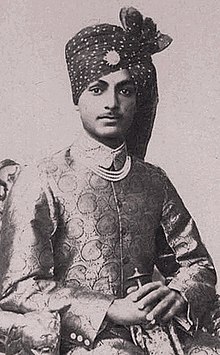Ghulam_Moinuddin_Khanji
Ghulam Moinuddin Khanji
Nawab, Khan
Ghulam Moinuddin Khanji (22 December 1911 – 13 February 2003) was the ruler of Manavadar State, one of the princely states associated with British India. Although Khanji chose to accede to Pakistan after the partition of India, the state was soon annexed by India and a subsequent referendum resulted in a massive Indian victory.
| Ghulam Moinuddin Khanji | |||||||||||||||||||||||||||
|---|---|---|---|---|---|---|---|---|---|---|---|---|---|---|---|---|---|---|---|---|---|---|---|---|---|---|---|
| Nawab, Khan | |||||||||||||||||||||||||||
 Ghulam Moinuddin Khanji in 1940s. | |||||||||||||||||||||||||||
| Khan of Manavadar | |||||||||||||||||||||||||||
| Reign | 19 October 1918 – 15 August 1947 | ||||||||||||||||||||||||||
| Predecessor | Fatehuddin Khanji | ||||||||||||||||||||||||||
| Successor | Monarchy abolished | ||||||||||||||||||||||||||
| Born | Ghulam Moinuddin Khanji (1911-12-22)22 December 1911 Manavadar, Bantva Manavadar, British India (present-day Gujarat, India) | ||||||||||||||||||||||||||
| Died | 13 February 2003(2003-02-13) (aged 91) Karachi, Sindh, Pakistan | ||||||||||||||||||||||||||
| Begum | Qudsia Siddiqa, Nawab Abida | ||||||||||||||||||||||||||
| Issue | Aslam Khan and 10 others | ||||||||||||||||||||||||||
| Father | Fatehuddin Khanji | ||||||||||||||||||||||||||
| Mother | Fatima Siddiqa Begum | ||||||||||||||||||||||||||
| Religion | Islam | ||||||||||||||||||||||||||
| Cricket information | |||||||||||||||||||||||||||
| Career statistics | |||||||||||||||||||||||||||
| |||||||||||||||||||||||||||
Medal record
| |||||||||||||||||||||||||||
Source: ESPNcricinfo | |||||||||||||||||||||||||||
An able sportsman, Khanji played first-class cricket for Western India and in his later life, was also the president of the Pakistan Hockey Federation.
Khanji was born as Ghulam Moinuddin Khanji at Manavadar, Bantva Manavadar (in present-day Gujarat, India) on 22 December 1911. He was the eldest son of Nawab Fatehuddin Khanji. His mother, Fatima Siddiqa Begum was the second wife of Fatehuddin. Moinuddin graduated from Rajkumar College, Rajkot.[1]
Khanji ascended the throne of Manavadar on 19 October 1918 after the death of his father.[1] Since he was only seven years old, his mother acted as Regent until 1931, when 20-year-old Khanji's investiture took place.[2]
Following the independence and partition of India in 1947, the princely states were invited to either join India or Pakistan or remain independent. On 24 September, Khanji acceded to the new Dominion of Pakistan.[3] However, on the orders of the Deputy Prime Minister of India Sardar Vallabhbhai Patel, India annexed the state on 22 October.[4] A referendum was held in Manavadar, Mangrol, and three other states. Out of 31,434 votes which were cast, 34 were in favour of Pakistan.[4]
Khanji was initially put under house arrest at Songadh and later arrested at Rajkot. In 1951, he left for Pakistan following the Liaquat–Nehru Pact.[5]
Khanji was the founder of the Manavadar hockey team coached by Mirza Nasiruddin Masood. Under his captaincy (?), the team toured New Zealand and won all the matches in 1934.[2][6] In the same year, he was a member of the India hockey team representing the country at the Western Asiatic Games.[2]
Khanji also played cricket and represented Western India in the Ranji Trophy between 1935 and 1941.[7] After migrating to Pakistan, he became the president of the Pakistan Hockey Federation.[8]
KhanSaheb was sometime captain of the Ranji Trophy cricket team, beside he led Manavadar cricket-hockey teams in national and international expeditions.
Khanji married his first wife Qudsia Siddiqa Begum, daughter of the Nawab of Kurwai on 14 November 1933. He married for a second time in July 1945 to Nawab Abida Begum. He had five sons and six daughters, the last of whom was born in 1963.[2] His eldest son Aslam Khan was also a cricketer.[9] One of Khanji's granddaughters, Sarwat Gilani, is an actress.[10]
Khanji's full name, with titles, was Major Nawab Ghulam Moinuddin Khanji Fatehuddin Khanji Babi, Khan Sahib of Manavadar. He received the Hilal-e-Quaid-i-Azam in 1953.
Khanji died on 13 February 2003 at the age of 92 at Karachi, Sindh province.[8]
- Who's Who in India, Burma & Ceylon (Who's Who Publishers (India) Limited, 1936), p. 541
- Heller, Richard; Oborne, Peter (2016). White on Green: A Portrait of Pakistan Cricket. Simon and Schuster. ISBN 9781471156434.
- "Junagadh: Legally Pakistan". The News on Sunday. 2 March 2014. Archived from the original on 27 December 2015. Retrieved 5 April 2019.
- Vidya Dhar Mahajan, Fifty Years of Modern India: 1919-1969 (S. Chand & Co., 1970), pp. 327–328
- "Mirza Nasiruddin Masud - 1936 Olympics Gold Medallist, UNESCO Chief, Ambassador". www.twf.org. Retrieved 13 October 2020.
- "Nawab of Manavadar". PCB Board. Archived from the original on 21 October 2022. Retrieved 5 April 2019.
- "KARACHI: Nawab Moinuddin laid to rest". Dawn. 15 February 2003. Retrieved 5 April 2019.
- "Aslam Khan". ESPNcricinfo. Retrieved 5 April 2019.
- Sharma, Sandeep (27 April 2015). "'I have a really good memory package from my India roots'". The Weekend Leader. Retrieved 5 April 2019.